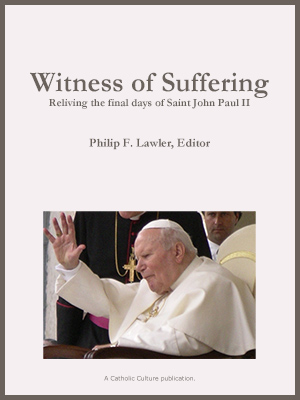Pilgrimage - they don't make it like they used to
By Thomas V. Mirus ( bio - articles - email ) | Mar 15, 2014
What’s the difference between a pilgrimage and a vacation? There was a time when going on a pilgrimage involved a great deal of sacrifice. Pilgrims traveled great distances to holy sites, often on foot, enduring great physical hardship to reach their destinations for some spiritual purpose – primarily to deepen their faith by establishing a physical connection with lands once trod by great saints, or by God Himself. The danger, cost in time and material goods, and effort required was such that pilgrimages were once ordered as penances or as punishments for crimes! A pilgrim often wore penitential garments for the duration of his or her journey. But because of modern transportation, much of the difficulty, and therefore much of the penitential element, of pilgrimage no longer exists.
Of course, suffering is not essential to a good pilgrimage, and there are so many positive reasons to embark on one that we should be thankful for its comparative ease nowadays. But there are other positives to modern travel which, not kept in proper perspective, threaten to distract us from the true nature of the quest. On the contrary, in the age of the tourism industry, luxury cruises and the like, the line between pilgrimage and vacation has been blurred to such a degree that even Catholic pilgrimage companies often focus their advertising more on the luxury, the wonderful foreign food, the exotic appeal of visiting a far-away place, and the scenic eye candy than on the religious and spiritual elements which define a pilgrimage.
One company that does not seem to fall into this trap is Saint Gemma’s Catholic Pilgrimages. The company organizes six trips to Rome per year, every one of which includes the owners, Mike and Sue Denz. While their website acknowledges the great food to be found in the Eternal City, it is clear that their focus is on the spiritual: on mass at St. Peter’s and audiences with Pope Francis, and on visiting and praying at various churches and holy sites. The pilgrimages offered range between nine and fifteen days. Pilgrims stay in a guest house run by nuns, which has its own chapel and is a mere seven-minute walk from the Vatican. They advertise practicality and flexibility (in relation to meals, schedule and pace of activity) above luxury. They emphasize that the purpose of the pilgrimage is to deepen one’s relationship with Christ through the Catholicity of Rome, in its art, architecture and culture, and most of all in its holy places and in the person of the Holy Father. At the same time, they allow a good amount of time for following one’s own interests and taking day trips to surrounding locations such as Florence and Assisi. In addition to all this, like many tour companies, they offer a free pilgrimage to anyone who wants to promote a trip in his or her parish or Catholic group. Overall, for those who have a mind to go on a pilgrimage, not a vacation, St. Gemma’s seems to be on the same page.
Note: When this article was written, the St. Gemma’s website indicated that as of March 1st there were a few spots still available on their John Paul II/John XXIII canonization pilgrimage, so there is an outside chance that someone who wishes to schedule a last minute trip might be able to squeeze in.
All comments are moderated. To lighten our editing burden, only current donors are allowed to Sound Off. If you are a current donor, log in to see the comment form; otherwise please support our work, and Sound Off!








